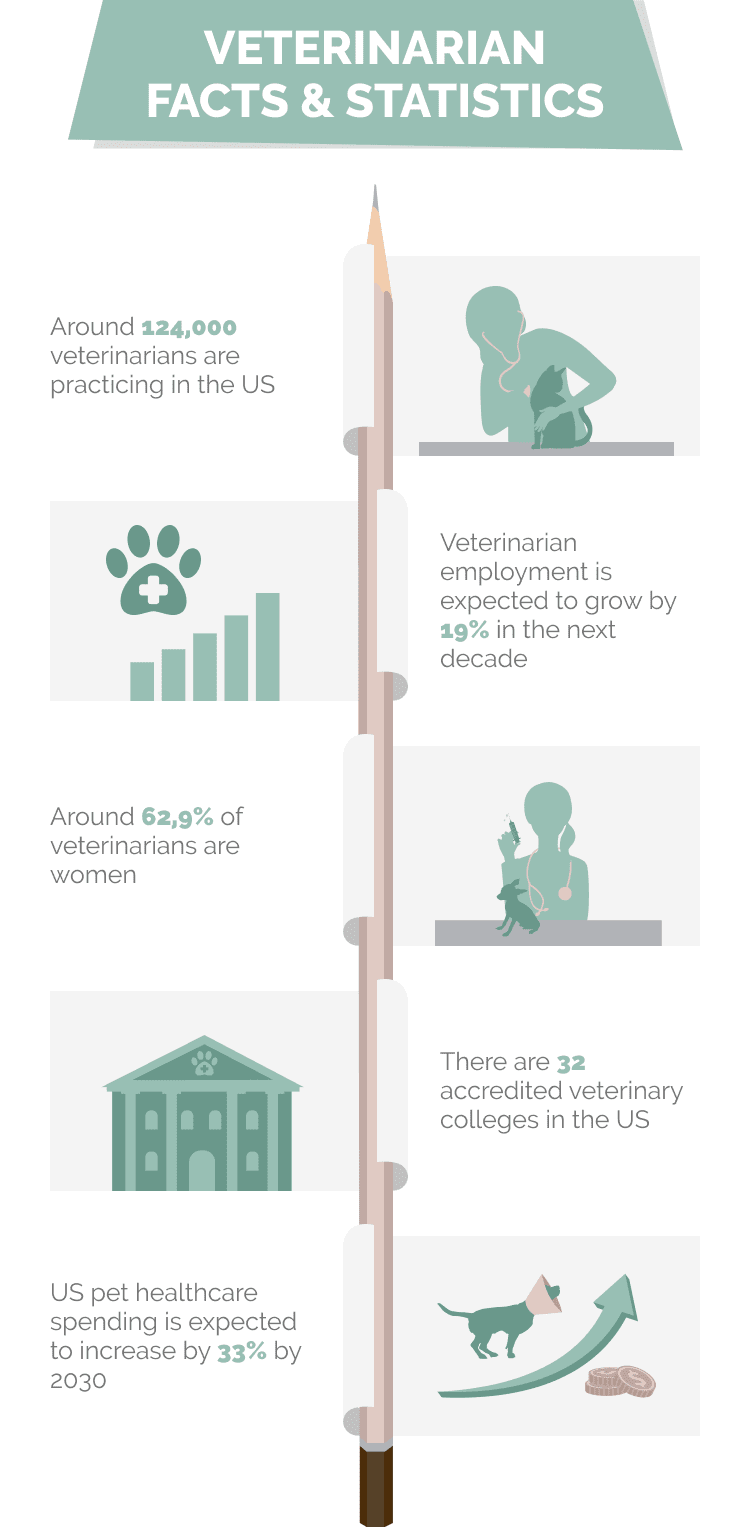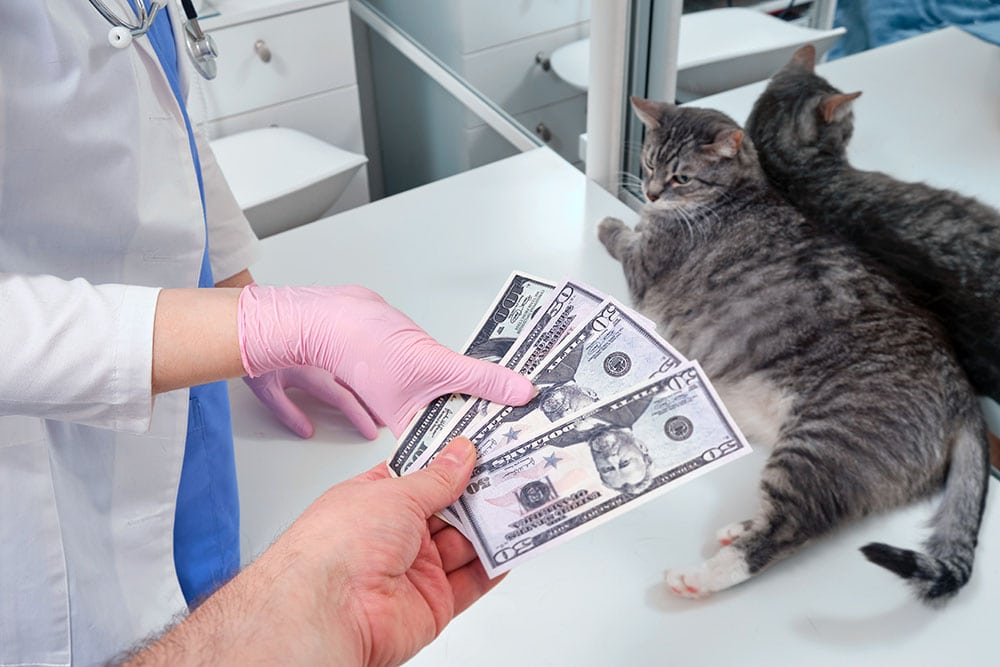15 Incredible Veterinarian Statistics & Facts: 2024 Update
Updated on

Click to Skip Ahead
Note: This article’s statistics come from third-party sources and do not represent the opinions of this website.
Veterinarians devote much of their lives to treating and saving animals. Veterinarians undergo intense training and schooling to provide care, which is often not an easy job. This career is demanding, stressful, and can be downright dangerous. On the other hand, it is very rewarding.
If you’ve ever contemplated becoming a veterinarian, check out our 15 veterinarian statistics and facts to help you decide if becoming a veterinarian is right for you.
The 15 Veterinarian Statistics & Facts
- As of 2022, approximately 124,069 veterinarians are practicing in the U.S.
- The American Veterinarian Medical Association (AVMA) recognizes 22 veterinary specialists.
- In 2021, the average pay for a veterinarian in the U.S. was $100,370 per year.
- Veterinarian employment is expected to grow by 19% from 2021 to 2031.
- 62,9% of veterinarians are women.
- Veterinarians are injured on the job more than police officers or firefighters by 12%.
- 3,200 veterinarians work for the federal government.
- U.S. pet healthcare spending is expected to increase by 33% by 2030.
- 75% of veterinarians specialize in companion animals
- There are 32 accredited veterinary colleges in the U.S.
- The acceptance rate for veterinary school averages between 10% and 15%.
- On average, vet school costs roughly $200,000.
- Veterinary ophthalmologists make roughly $138,00 in Washington.
- Military veterinarians make, on average, $103,090 per year.
- Board-certified veterinary surgeons make, on average, $266,908 per year.

General Veterinarian Facts
1. As of 2022, approximately 124,069 veterinarians are practicing in the U.S.
(AVMA)
Veterinarians go into the field because of their love for animals. Many veterinarians treat companion animals, but some treat exotic pets and horses, or they may specialize in a mixture of animals. However, the bulk of veterinarians specializes in companion animal care.

2. The American Veterinary Medical Association recognizes 22 veterinary specialists.
(Ross University)
For those seeking to become a veterinarian, you have many different fields to go into. When it comes to animal care, many factors play a role in the type of services needed. Among some of the few services are anesthesia, dentistry, ophthalmology, emergency care, and radiology.
3. In 2021, the average pay for a veterinarian in the U.S. was $100,370 per year.
(BLS)
Half of veterinarians make less than this number, and half make more. The pay fluctuates depending on the location and the type of veterinary specialty. An average of 10% earned less than $60,076, and the highest 10% of veterinarians made close to $165,0600.

4. Veterinary employment is expected to grow by 19% from 2021 to 2031
(BLS)
A projected growth of 19% is much higher than all other occupations, which usually come in at a 5% projected growth. Veterinarians are always in high demand, and as veteran veterinarians retire, there will be openings for younger and newer veterinarians. The many specialty fields also open up many opportunities.
5. 62.9% of veterinarians are women.
(Zippia)
Women make up the bulk of veterinarians in the U.S., with men coming in at 37.1%. Studies show that women make less than men in the veterinary field, and men expect to be paid more within this industry. Due to an expectation of more pay, more and more women are entering the field as opposed to men, causing the incline.

6. Veterinarians are injured on the job more than police officers or firefighters by 12%.
(AAHA)
If you think police officers and firefighters are injured more than veterinarians, think again. Veterinarians endure animal bites, scratches, and infectious agents, to name a few. In 2016 alone, the US Department of Labor reported that 12% of veterinarians reported work-related injuries, surpassing nurses, police officers, firefighters, and construction workers.
7. 3,200 veterinarians work for the federal government.
(FDA)
Not all veterinarians work in private practices. Of these 3,200, half are employed through the Department of Agriculture. The rest work with elephants, the National Zoo, go into space with NASA, and some are even elected into Congress. Some also work within the Food and Drug Administration to ensure that drugs and food are safe for both humans and animals.

8. U.S. pet healthcare spending is expected to increase by 33% by 2030.
(AAHA)
Pet owners do not hesitate to spend money on their pets. With such an expected increase in spending, the demand for veterinarians will rise. This speculation could cause veterinarian schools to expand enrollment opportunities to account for the demand.
9. 75% of veterinarians specialize in companion animals
(St. George’s University)
Most veterinarians choose to work in private practices helping companion animals, and these types of veterinarians make up the bulk of the field. Companion animals mostly consist of dogs and cats but can include horses, ferrets, rabbits, and small mammals.

 Veterinary Education Statistics
Veterinary Education Statistics
10. There are 32 accredited veterinary colleges in the U.S.
(AAVMC)
All 32 accredited veterinary schools are scattered throughout the United States, with the University of California in Davis being ranked #1. This school has a 6.72% acceptance rate for California residents and a 3.69% out-of-state success rate. The school is known to have the best value for veterinary school.
11. The acceptance rate for veterinary school averages between 10% and 15%.
(Veterinarian Edu)
Getting accepted into a veterinary school is no easy task, and the competition is comparable to medical school. Applicants have a better chance of getting into a veterinary school where they reside, as 50% or more applicants are generally accepted in their home state.

12. On average, vet school costs $200,000.
(Nerd Wallet)
It should be no surprise that attending veterinary school is costly. Even though students tend to spend less if they attend a veterinary school in their home state, the average is still in that range. In fact, out-of-state students spend an average of $275,000 on their veterinary education.
Veterinarian Specialties and Statistics
13. Veterinary ophthalmologists make roughly $138,00 in Washington.
(Zip Recruiter)
In the state of Washington, veterinarian ophthalmologists make a handsome living, with an average salary of $96,000 across the U.S. More is involved in becoming a veterinarian ophthalmologist, including a three-year ophthalmology residency requirement.

14. Military veterinarians make, on average, $103,090 per year.
(Indeed)
The United States military needs veterinarians to provide care for our nation’s military dogs and other animals in conflict zones. These veterinarians also provide animal care in undeveloped countries, as well as conduct research for the United States military.
15. Board-certified veterinary surgeons make an average of $266,908 per year.
(Indeed)
Board-certified veterinary surgeons require extensive training that goes beyond a licensed veterinarian. These surgeons also diagnose illnesses and formulate treatment plans and rehabilitation programs for complex conditions.

Frequently Asked Questions About Veterinarians
What Type of Degree Is Required for Applying to Vet School?
You can enter veterinary school with an undergraduate degree. However, ensure you follow your school’s prerequisite coursework requirements. Put it this way: you could have a 4.0 GPA and not get into vet school because you did not follow the prerequisite requirements. You also do not necessarily need an undergraduate degree as long as you complete any and all prerequisites, which can take 3 years.
Regarding an undergraduate degree, people with backgrounds in math, science, engineering, English, and many more have entered the program. (AVMA)
How Can I Prepare for Veterinary School While in High School and College?
As we’ve mentioned, ensure you take all the necessary prerequisite work. Apart from the prerequisites, you can start preparing for veterinary school as early as high school. Beneficial resources involve volunteering at your local Humane Society, pursuing a math and science background, maintaining a high GPA, shadowing veterinarians in animal shelters and farms, and joining a Pre-Vet club. (AAVMC)

What Other Animal-Related Jobs Are There?
If you’re not sure about becoming a veterinarian, there are plenty of other jobs you can pursue that involve taking care of animals. Veterinary technicians and assistants are always needed to work alongside veterinarians.
You can also pursue animal behavior and training, get involved with conservation, work at a zoo or animal shelter, or get involved in animal research and education. Luckily the possibilities are endless, and not all require extensive schooling. (Moneygeek)
What State Pays Veterinarians the Most?
Arkansas is the #1 highest-paying state in the U.S., with veterinarians in the state averaging 146.7% higher compared to other states. Remember that you are more likely to get accepted into a veterinary school in your home state, and if you live in Arkansas and are interested in becoming a veterinarian, you can make a comfortable living. (Veterinarians.org)
Conclusion
A career in the veterinary field is both challenging and rewarding. Veterinarians do more than treat animals; they also comfort pet parents during times of stress, and they must endure putting animals to rest.
Veterinarians work long hours and sacrifice time with their own families and pets to care for others. However, becoming a licensed veterinarian can be a dream come true for those who love animals and want to help them.
- See Also: Veterinary Telehealth Statistics & Facts
Featured Image Credit: Viktor Gladkov, Shutterstock

 Veterinary Education Statistics
Veterinary Education Statistics







